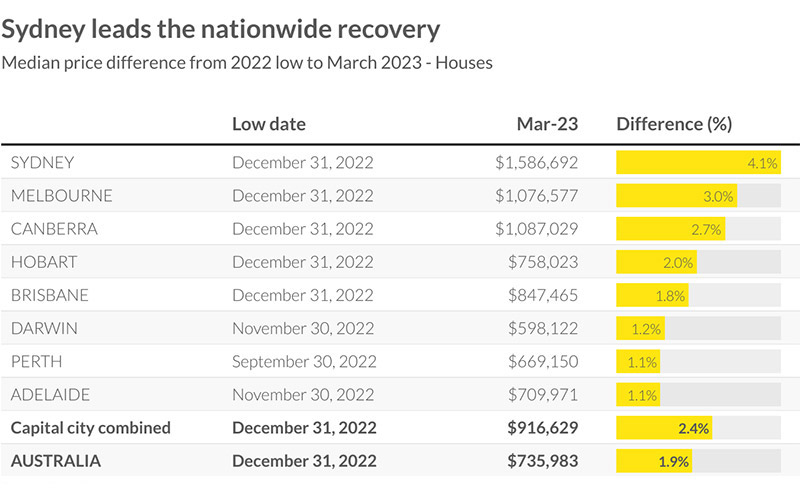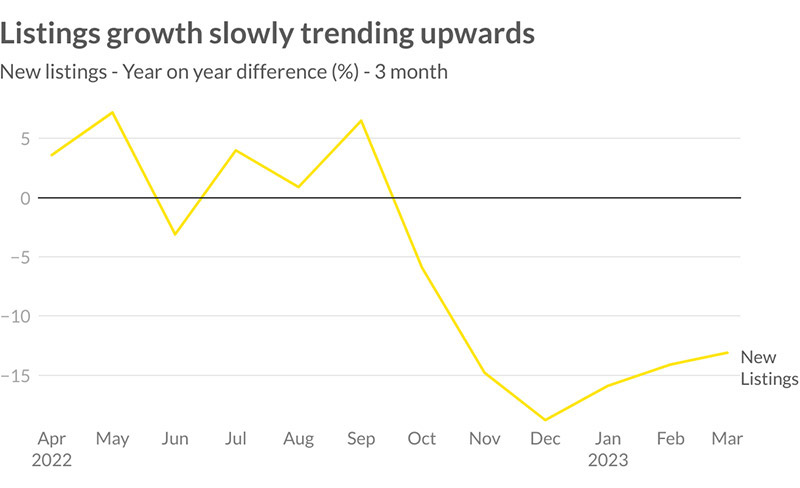Sydney leads the charge as national property prices rise
Property prices in Australia have risen for the first time in 10 months, fuelled by growth in the major state capitals.
Signs are emerging that the property market may be turning a corner earlier than was widely expected, with national property prices rising by 0.6 per cent in March.
Property forecasters’ widely circulated expectations that dwelling values would continue to slide until later this year, when the cycle of interest rate hikes was tipped to end, may have been overly pessimistic.
In the facing of diminishing supply and increasing migration from overseas, property prices were higher across the four largest capital cities and most of the broad ‘rest-of-state’ regions.
According to the CoreLogic Home Value Index, a lift in prices in Sydney’s top end delivered price growth of 1.4 per cent for the Harbour City.
The rise in CoreLogic’s national property price index was the first since April 2022.
In every capital city, prices are now back to where they were mid last year.

Source: CoreLogic.
Nerida Conisbee, Chief Economist, Ray White, said that if the current rate of growth continues, there is the potential for declines seen in 2022 to be completely reversed by the second half of 2023.
“Like every downturn, we have seen prices fall far less than what is generally predicted.
“Housing markets almost always surprise with strength on the upside and see far less robust declines when the market turns.”
Why are property prices rebounding?
CoreLogic’s Research Director, Tim Lawless, said advertised supply has been below average since September last year, with capital city listing numbers ending March almost 20 per cent below the previous five-year average.
“Although interest rates are high and there is an expectation the economy will slow through the year, it’s clear other factors are now placing upwards pressure on home prices,” Mr Lawless said.
“Purchasing activity has also fallen but not as much as available supply; capital city sales activity was estimated to be roughly 7 per cent below the previous five-year average through the March quarter,” he said.
“With rental markets this tight, it’s likely we are seeing some spillover from renting into purchasing, although, with mortgage rates so high, not everyone who wants to buy will be able to qualify for a loan.
“Similarly, with net overseas migration at record levels and rising, there is a chance more permanent or long-term migrants who can afford to, will skip the rental phase and fast track a home purchase simply because they can’t find rental accommodation.”
Ms Conisbee said dampening inflation and concerns around a potential global banking crisis could signal interest rates had already hit or neared a peak.
“If we are at a peak, this will be further impetus for price growth to continue for the remainder of the year.
“In places we are seeing the strongest increases in rents, such as south east Queensland, it is possible price increases will hit double digits over the next 12 months.
“In this cycle, the peak to trough decline of Australian capital city house prices was 6.5 per cent, compared to COVID-19-driven price growth of 36 per cent.”

Source: Neoval/Ray White.
Listings may climb with prices
The mixed signals in the economy have been exacerbated by multiple building company collapses this year.
William Clark, Data Analyst for Ray White, said households are unlikely to have an easy time getting a grip on the true outlook, and this was being reflected in only modest improvement to the year’s overall listings trend.
He said that among the major cities, Sydney, Canberra and Melbourne are still well down on the same month last year. Brisbane, Darwin and Perth saw more moderate losses to listings, while Adelaide and Hobart saw modest increases to listings at this time last year.

Source: Neoval/Ray White.
“With prices improving, this will encourage more and more vendors to come to market as the return on their current dwelling improves, and the property they potentially relocate to becomes less affordable.
“As listings lag prices, should strong price growth continue, it is likely listing numbers will follow,” he said.
Home value consensus
It’s not always the case, but there is broad consensus between property data company prices indices, with PropTrack concurring with CoreLogic that a real estate recovery is underway.
Their analysis found that national home prices were up 0.13 per cent nationally month-on-month in March, for a cumulative increase in 2023 of 0.49 per cent.
Sydney (+0.27 per cent), Perth (+0.24 per cent) and Melbourne (+0.12 per cent) recorded the largest jumps. Adelaide (+0.10 per cent) also saw prices increase, while prices in Canberra increased slightly after a flat February (+0.03 per cent).
While prices continued trending upward in most capital cities, Hobart (-0.43 per cent), Brisbane (-0.06 per cent) and Darwin (-0.10 per cent) saw declines, according to PropTrack.
While home prices have fallen from their peak in most markets, prices nationally are still 30 per cent above their pre-pandemic levels.
PropTrack Senior Economist Eleanor Creagh said the prospect of further property price still hung in the balance.
“Headwinds remain, with the full impact of recent rate rises yet to be felt, which means the decline in prices could still find a second wind, particularly if new listing volumes increase in the coming months.
“While the significant reduction in borrowing capacities and deterioration in affordability caused by interest rate rises implies larger price falls, the impact of rate rises is being counterbalanced.
“Positive demand drivers offsetting the downwards pressure include the strong rebound in immigration, tight rental markets and (slowly) increasing wages growth.
“The sustained softness in new listing volumes is also keeping a floor under prices,” Ms Creagh said.



















